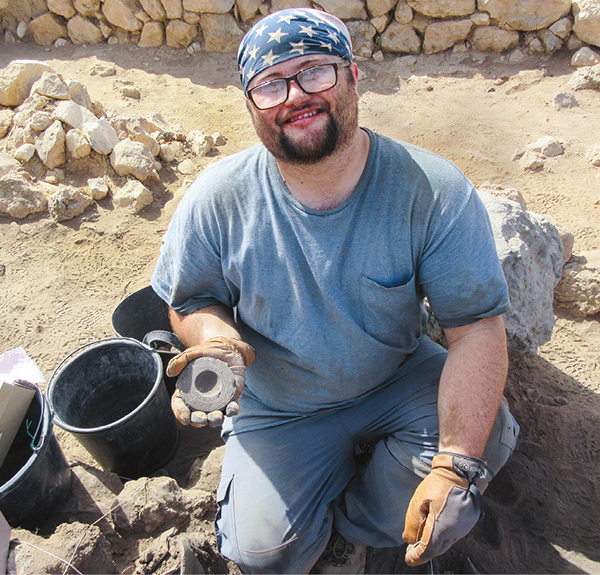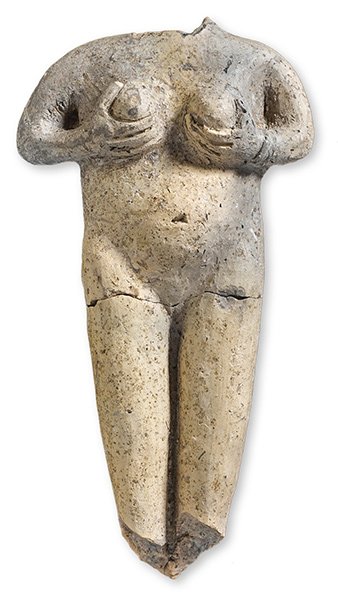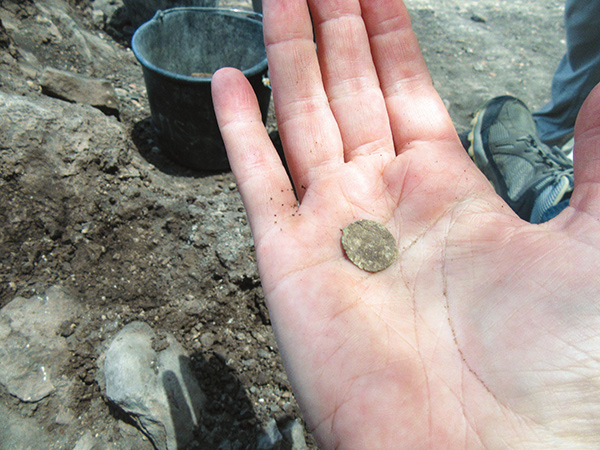Digs 2017: Digging Through Time
026027

You decided you want to pick up a trowel and excavate the Bible, but, like picking up the book itself, you have to choose where to start. If you want to start at the beginning, you will have some difficulty in deciding where to start digging. If you want to find remains from the time of King David, then you need an early Iron Age site. But perhaps you want to excavate a street on which the apostle Paul might have strolled—then you better look for a Roman-period excavation.
Time periods provide context to archaeological excavations, right down to the level of individual squares. “Archaeology brought history to life for me,” Michael Doll, Tell Halif volunteer and junior at William Jessup University, mused about his experience excavating the Iron Age. “Digging through the strata, you are literally going back in time and shedding light on things that have been buried for thousands of years.”
So what are these periods that divide human history as it relates to Israel and the Levant, a region in the eastern Mediterranean that includes all or part of Cyprus, Egypt, Iraq, Israel, Jordan, Lebanon, Palestine, Syria and Turkey?
The archaeology of the Levant begins with the Stone Age (1,000,000–3300 B.C.E.), which consists of the Paleolithic (1,000,000–8300 B.C.E.), Neolithic (8300–4500 B.C.E.) and Chalcolithic (4500–3300 B.C.E.) periods. The Stone Age is largely defined as when humans began making stone tools and weapons with a sharp edge or point—without the use of metal. While important human developments, such as the cultivation of fire and the invention of pottery, arose during this period, it mostly predates what is generally thought of as Biblical archaeology.
This of course does not mean that the Stone Age is not excavated in Israel. For example, Tel Tsaf,028 directed by Danny Rosenberg of the University of Haifa and Florian Klimscha of the German Archaeological Institute of Berlin, is focused entirely on the Middle Chalcolithic period. “There are no Biblical references associated with Tel Tsaf,” explains recent University of Sydney graduate Sarah Carter, “and being a prehistoric site, the only accessible history is the one that archaeologists have constructed and continue to construct from the material remains.” Despite this, the Stone Age could form the backdrop for some of the legends in the Bible’s primeval history (Genesis 1–11).

Because many archaeological sites in Israel arose in the Bronze Age, it wouldn’t be hard to conclude that Biblical archaeology also begins with the Bronze Age (3300–1200 B.C.E.). The Bronze Age is divided into three sub-divisions: Early (3300–2200 B.C.E.), Middle (2200–1550 B.C.E.) and Late (1550–1200 B.C.E.). A civilization is considered to be from the Bronze Age either because it smelts its own copper, creates a copper alloy—bronze—or it trades such products. This is also the period in which writing emerges in the Near East, specifically in Mesopotamia (cuneiform) and Egypt (hieroglyphic). Biblically this period provides the setting for the books of Genesis (starting in chapter 12) through Judges.
The setting behind Abraham and the early Founding Families narratives in the Bible (Genesis 12–25) would be the Early Bronze Age (or, alternatively, the Middle Bronze Age). From excavations, such as the one being conducted by Norma Franklin of the University of Haifa and Jennie Ebeling of the University of Evansville at Jezreel, we can gain insight into some of the cultic practices that took place in the “Promised Land” at the time. “I was aware of the general history of the site and its significance in the Biblical narrative,” states Emily029 Stewart, a recent graduate of the University of Evansville. “Such information provides meaningful context either to be disproved or affirmed by the archaeological record.” For example, the Jezreel team in 2016 discovered a large standing stone—usually used to represent a deity in the ancient Near East—with restorable pottery that yielded contents for laboratory testing. According to the directors, “even in the [Early Bronze Age], the standing stone once stood on the summit of the site.”a

Tel Hazor, under the direction of Ammon Ben-Tor and Shlomit Bechar of the Hebrew University of Jerusalem, is known from the Bible as the most important city in the region during the Bronze Age (Joshua 11:10). “I was unaware of the pivotal role Hazor played during this period, specifically, its influence and connection to the rest of the ancient world,” first-time undergraduate volunteer Jilian Bernstein from the University of King’s College in Halifax, Nova Scotia, recounted. “Our time digging at Hazor was supplemented with lectures. This added cultural context to what we were digging and cleaning. Knowing the role the tell played in the Biblical world made finding small personal effects, such as a gold earring, all the more interesting, as it added a personal lens to a grand narrative.”
Occupied during the Bronze and Iron Ages, the site identified as the Biblical town Abel Beth Maacah in northern Israel (2 Samuel 20:14; 1 Kings 15:20;030 2 Kings 15:29) is being excavated under the direction of Robert Mullins of Azusa Pacific University, Nava Panitz-Cohen of the Hebrew University of Jerusalem (HUJ) and Naama Yahalom-Mack of HUJ. A silver hoard found in a small jug, dating to the 13th century B.C.E., the end of the Late Bronze Age (making it one of the earliest of its kind), paired with mundane material culture flesh out the picture of daily Canaanite life. Because of its location on the northern border of modern Israel, this site has the potential to shed light on relations among the Canaanites, Arameans, Phoenicians and Israelites in the Bronze and Iron Ages.
Following the Bronze Age is the Iron Age (1200–586 B.C.E.), which is defined by a transition from tools made out of bronze to iron (although stone and bronze continued to be used). In the Iron Age there is also large-scale advancement in literary productivity and the dominance of alphabetic scripts. The Iron Age represents the period in which Israel as a nation is born, thrives and loses its independence. The Iron Age I (1200–1000 B.C.E.) roughly equates to the emergence of the nation through the establishment of the monarchy; the Iron Age II (1000–586 B.C.E.) covers the period of the monarchy to the Babylonian Exile.

According to the Bible, over the span of 800 years, Israel transformed from a loose tribal federation to a monarchy under King Saul. The capital was moved to Jerusalem by King David, and the wise king Solomon built a Temple there during his reign. The Israelites experienced civil war, and the nation divided into the Northern Kingdom of Israel, which was destroyed by the Assyrians in 722 B.C.E., and the Southern Kingdom of Judah, which was conquered by the Babylonians in 586 B.C.E. when they finally overthrew Jerusalem and destroyed the Temple (2 Kings 25:9). In a series of three deportations, 4,600 elite Judahites found themselves taken into captivity in Babylon (Jeremiah 52:28–30).
Timna plays an essential role in this period, as a large copper mining and smelting site. Recent radiometric and paleomagnetic dating by Tel Aviv University’s Central Timna Valley Project (CTV) has redated Timna to a predominantly early Iron Age site—bringing back the possibility that these were “King Solomon’s mines.” As long-time staff member and Tel Aviv University graduate student Ilana Peters tells us, “Previous to our survey and excavations, it was not known that there had been such extensive Iron Age copper smelting activity throughout the Timna Valley.” Spirits were far from dampened by this new information: “Every day in the field gives us an opportunity to discover remains that can help us better understand the ancient metallurgic industry,” says Aaron Greener, the Ernest S. Frerichs Fellow and Program Coordinator at the W.F. Albright Institute of Archaeological Research.
Excavations are also shedding light on ancient Israel’s enemies, including the Philistines. “Modern excavations at the Philistine sites of Ashdod, Ekron,032 Ashkelon and Gath (Tell es-Safi)—four city-states of the Philistine Pentapolis—have demonstrated that the Philistines brought their own distinctive types of pottery, building styles, weapons, jewelry and weaving with them when they settled on the southern coast of what became Israel around the 12th century B.C.E.,” says BAR Managing Editor Megan Sauter, who took part in her fifth season at Ashkelon.b This picture is further expanded by a major Philistine cemetery excavated at Ashkelon. The 2016 excavations also illuminated the destruction of Philistine Ashkelon at the hands of Nebuchadnezzar of Babylon, in 604 B.C.E.


When the Persian ruler Cyrus the Great conquered the Babylonian empire in the sixth century B.C.E., he allowed the Israelite exiles to return home (538 B.C.E.). He also allowed the Jerusalem Temple to be rebuilt. This is referred to as the Persian period (586–332 B.C.E.).


At Tell Halif—perhaps Biblical Rimmon—many Persian/Hellenistic figurines were unearthed. How do we date these clay mold-made figurines? By the style of the figurine. In earlier periods they had exaggerated features, but the use of molds in the Persian period allowed for proper proportions, and this is therefore a defining feature for the images made in the Persian period—a process that was 033perfected in the Hellenistic period.

“For the Persian period, the identification of the site has interesting ramifications,” explains Tell Halif team member Tim Frank of the University of Bern. “According to Nehemiah (Nehemiah 11:29), Jews returning from the Babylonian Exile settled in Rimmon. The question then arises as to how [Israelite religion] moved from very little cultic depiction in the Iron Age to this plethora of figurines in the Persian period.”
Alexander the Great conquered the area in 332 B.C.E., marking the end of the Persian period. Alexander’s death begins the Hellenistic period (323–31 B.C.E.), when Greek culture spread throughout the conquered lands.
Situated high above the eastern shore of the Sea of Galilee, Hippos-Sussita was founded in the mid-second century B.C.E. by the Seleucids, later becoming one of the ten cities of the Decapolis. “While excavating, I was very aware of the history behind the site as it informed how the excavation was conducted,” says Tabitha Williams, a graduate student at Carlton University in Ottawa, Canada. “This mattered to me because it provided context while excavating, leading to a greater understanding of the finds and the site itself.” The archaeology of the site reveals long-lasting Greco-Roman traditions that extended beyond the Hellenistic and Roman periods.


035
The Roman period in the Levant spans c. 37 B.C.E. to 324 C.E. The Romans appointed local regents to rule for them in Judea. The most famous of them was Herod the Great, who, although often despised by the people, was a major architectural force. He rebuilt the Temple in Jerusalem, built the palace-fortresses at Masada, Herodium and elsewhere, and created the major port at Caesarea Maritima.
During the Roman period, an itinerant teacher was born, ministered and died; his name was Jesus. His followers debated his teachings for many centuries after his death, and some believed he was the longed-for messiah who would start a political revolution. Some of his followers also wrote down stories about him, and some of these stories became the New Testament. Though this religion began as a splinter group of Judaism, it soon emerged as Christianity.
Beyond the Jesus movement, other Jewish locals were not any happier under Roman rule. Two major Jewish revolts occurred: the First Jewish Revolt in 66–70 C.E., which resulted in the destruction of the Jerusalem Temple, and the Second Jewish Revolt, led by Simon Bar-Kokhba, which was crushed in 135 C.E. Jews were banned from Jerusalem, and Sepphoris, a Roman town with a distinctly Jewish presence, became the new home of the Sanhedrin, the Jewish religious court.
Magdala, the hometown of Mary Magdalene in the Bible, is historically important in modern times as well as in the first century C.E. It is the first Mexican-led excavation to receive a permit in Israel, and its director, Marcela Zapata-Meza of the Anahuac University of Mexico, is the first Mexican woman to lead a dig outside of Mexico. “Magdala is a Roman-era city, but a Jewish one,” says volunteer and St. John’s College faculty member Zena Hitz. “Part of what makes the site so fascinating is the interaction and the tension between these two cultures. The archaeologists think the city—or a big part of it—was abandoned when the First Jewish rebellion was crushed. So we find, on the one hand, Roman coins (I found one!) and, on the other, stone walls hastily set up in city streets to keep out Roman soldiers.”
With the legalization of Christianity in 313 C.E., followed by the death-bed conversion of Emperor Constantine in 337 C.E., the Byzantine period036 (324–634 C.E.) begins. Although the period comes after the New Testament was written, many of the Christian apocryphal texts were penned during this time.


These diverse time periods serve as a helpful guide to the past, but they can also contain as much mystery as clarity.
“It is astonishing how interesting dirt becomes when you look at it carefully,” concludes Zena Hitz. “But in the end you have to live with a lot of mystery and uncertainty. Why is this wall here rather than there? What kind of building was it, and where is the rest of it? Why are there animal bones in this place? Why is this stone in this shape? A volunteer like me can ask the experts, but the experts often live with even more mystery than we do! But whoever these people were, the human beings of the past who lived and worked in this place made and touched and destroyed these things. Even in the most apparently boring pile of dirt and rocks, there’s a profound connection with the past even in the midst of all of our ignorance.”
Each year students and volunteers from around the world travel through time by participating in excavations. We explore the history of the land of the Bible as we dig into the archaeological past. Learn about this year’s exciting excavation opportunities!
You have already read your free article for this month. Please join the BAS Library or become an All Access member of BAS to gain full access to this article and so much more.
Already a library member? Log in here.
Institution user? Log in with your IP address or Username
Footnotes
Jennie Ebeling and Norma Franklin, “Jezreel Expedition 2016: Jezreel Through Time,” Bible History Daily (blog), originally published on July 7, 2016.
